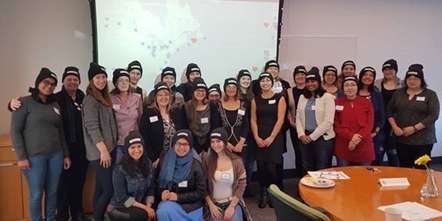
As day broke around the world on February 12 an array of hearts steadily lit up on a global map mounted on the Web site of the International Union of Pure and Applied Chemistry (IUPAC), each signifying the location of a networking event dedicated to women in chemistry. Thousands of people around the world took part in the Global Women’s Breakfast, including several hundred in Canada, where the first heart to light up was at Cape Breton University in Sydney, NS. It was one of 10 such hearts across the country, encompassing a diverse collection of formal talks, engaging discussions, innovative interactive activities, and an opportunity simply to get together with like-minded individuals who are passionate about chemistry.
Belinda Heyne, who organized the University of Calgary event, demonstrated just such passion by taking advantage of her qualifications not just as an associate professor in the Department of Chemistry but also as a certified facilitator in LEGO® SERIOUS PLAY® methods. After giving each of the breakfast attendees a bag of LEGO® she asked them to build a duck. The result was a room full of ducks that looked very different from one another, something that Heyne offered as a testament to the importance of diversity in science and society.

University of Calgary included ducks unlimited [Alison Fulton]
There may not have been ducks at the other breakfast events, but the same theme resonated throughout each of the breakfast events. Other host institutions included University of Toronto, Western University, and Univesity of Saskatchewan.
“Our attendees were happy to meet off-campus and enjoyed networking with members of the department,” said Meagan Oakley, a University of Alberta doctoral student who arranged for her institution’s breakfast to take place in a local diner. “We hope that the event helped to foster a sense of community and create an environment where chemists from all backgrounds are welcome to share their perspective.”
Other participants came from outside the academic environment to recall how their experience as students shaped their subsequent careers. Geneviève Tanguay, the National Research Council’s vice-president of Emerging Technologies, shared such stories with the Global Women’s Breakfast held in Ottawa. She cited the importance of people who believed in her and supported her as mentors, a group that included scientific colleagues as well as her own family.
“In the course of my career, I had many role models who often became my sponsors,” she said. “They saw things in me that I didn’t see, and they not only encouraged me, but also promoted me. I can’t stress enough the importance of supporting and encouraging young women in STEM as having this type of diversity will help to connect skills, creativity, and talents to expand research across our communities.”
Participants at the University of Manitoba also gained a sense of their place in a larger scientific system by creating a wall-size periodic table with the names of elements linked to the names of women in science, such as Cu for Marie Curie and Ar or Fr for Frances Arnold. Although the periodic table was not completed at the breakfast, it was subsequently mounted in the library, where others were asked to add to it.
Juliana Vidal, a doctoral student who was among the organizers of the breakfast at Memorial University of Newfoundland, found the entire process of creating such an event to be rewarding and meaningful.

St. Mary’s University at Halifax got baking for breakfast [Danielle Boudreau]

Cape Breton University was the first Canadian site to put its heart on-line [Stephanie MacQuarrie]

Events included speakers … [Stephanie Gallant]

… and networking [Jennifer van Wijngaarden]
